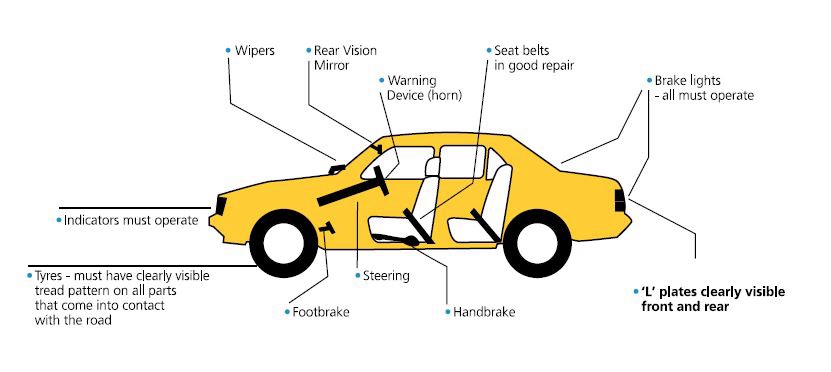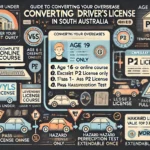For those learning to drive in South Australia, the Vehicle On Road Test (VORT) is a vital stepping stone to acquiring a driver’s license. It is a detailed driving test that gauges your understanding and application of road rules and regulations. Central to this test is the VORT marking sheet – a meticulous record of your performance throughout the examination.
The Starting Point
The VORT begins at a government-determined location and adheres to a preset route. Its start time is pre-booked by the examiner via the DIT (former DPTI) computer system and cannot commence earlier to accommodate possible audits. Auditors, if present, sit immediately behind the driver’s seat, watching the examiner’s conduct rather than the learner’s performance.
The Vehicle Check
Before embarking on the test, the examiner performs a brief vehicle check. This includes validating the operation of the vehicle’s indicators, brakes, and tyre tread. The examiner ensures that the vehicle is in a legal and safe state for the test.

The VORT Recording Sheet
The VORT recording sheet is the examiner’s tool to document the test progress and results. It records the details of the student, examiner, test timing, route specifics, and vehicle data. It is divided into different sections, each with a specific role:

Immediate Fail Items: Records situations that immediately disqualify the learner from the test. Usually, this involves breaches of road law or situations where the examiner must intervene.
- Disobey traffic light, signs and road marking
- Fail to Give Way
- Drive Dangerously or Without Care
- Speeding
- Need Examiner Intervention
- Fail to Follow Examiner’s Directions
Check here for details.
General Drive Recorder: This segment records the general drive, corresponding with the route directions. If a student completes all criteria of a step correctly, the examiner will mark the ‘Yes’ column. Conversely, failure to meet all criteria results in a note in the ‘No’ column.
The marking process involves various codes like M (mirrors), S (signal), A (approach), P (position), T (turn), O (observation), and J (judgement). These codes assist the examiner in evaluating your driving based on different criteria.
M – Mirrors:
- Checks must be done prior to any manoeuvre like turning or slowing down.
- The centre mirror and an exterior mirror (if appropriate) must be checked.
- Mirror checks should occur before giving a signal or slowing down.
- The mirror check should be performed no more than 5 seconds prior to the signal.
S – Signal:
- This code pertains to correct usage of direction signals.
- The signals must be given correctly and at the appropriate time to avoid misleading other road users.
- The signal must be given after the mirror check, not at the same time or before.
A – Approach:
- This relates to how the student approaches a turn or hazard.
- The speed of approach should be appropriate for the situation.
- The student should use an appropriate course for their approach.
Q – Sequence:
- This code is used to mark if a mirror check, signal, or approach was performed out of sequence.
- Most commonly, this happens when the signal is activated before checking the mirror.
P – Position:
- This checks whether the student is in an appropriate position on the road.
- It considers if the student is waiting to turn in the correct position, and driving in the correct lane or as close to the left as practical on an unlaned road.
T – Turn:
- This relates to the correct execution of turns at intersections.
- The student should stay in lane and enter the correct side of the new road.
- Incorrect turns, like cutting corners or turning wide, may lead to an immediate fail.
O – Observation:
- This code does not include mirror checks; instead, it focuses on other observational skills.
- This includes checking blind spots when changing lanes, and scanning intersections before crossing them.
J – Judgement:
- This assesses the student’s ability to make safe decisions on the road.
- It checks whether the student takes safe gaps and does not hesitate unnecessarily when emerging.
- Failure in judgement may lead to immediate fails for not giving way or causing obstruction.
Special Situations:
Four codes – SPEC (special situations), MARG (collision avoidance space), PROG (progress), and V.CON (vehicle control) – are assessed once per test section. They cover unique scenarios that may occur during the test and contribute to the overall driving score.
Scoring the General Drive
At the end of the test, the total number of marks in the ‘No’ and ‘N/A’ columns are counted. This total is subtracted from the total criteria to give the number of criteria assessed, which is converted into a score out of 90.
5 Manoeuvres
The manoeuvres are recorded separately, with each successful manoeuvre worth 2 marks. This score contributes to a total out of 10, which is added to the general drive score to give an overall mark.
- Moving off from kerb
- Three Point Turn
- U-Turn
- Reverse Parallel Park
- Angle Park
Check here for details.
General Drive Comments
Examiners expand on any criteria not met (those in the ‘No’ column of the general drive) in this section. It provides learners with specific feedback on their performance.
Result
A passing score is 90 or above, provided there are no immediate fail items. The examiner will calculate your score, provide feedback, and, if you pass, issue a certificate of competence.
End of the Test
Whether you pass or fail, it is essential to listen and understand the examiner’s comments – they aim to help you become a safer and more confident driver. If possible, having your instructor present during the examiner’s feedback can be beneficial for your learning journey.
The VORT marking sheet can initially seem complex, but understanding its structure and purpose helps demystify it. It is a vital tool in the VORT, documenting your progress and providing a structured way for the examiner to assess your skills and provide useful feedback. Good luck on your test!

